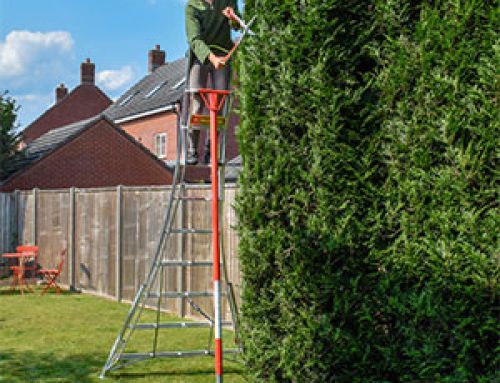Most people in the business of installing or maintaining electrical equipment at height or tree surgeons trained in the skill of pruning round wires, are aware of the need to use fibreglass ladders as well as specialist equipment which will reduce the risk of an electric shock. However, most homeowners are either not aware of these risks or do not realise  the severity of the electric current involved: a shock from a faulty plug socket in the home is nothing like the shock from an overhead cable.
the severity of the electric current involved: a shock from a faulty plug socket in the home is nothing like the shock from an overhead cable.
People also fail to realise that trees can conduct electricity. When a tree grows near to power lines and is in regular or constant contact with the line, it can become energised and is capable of passing on an electric shock. Two recent cases in America involved homeowners pruning trees and shrubs on their properties. One man was hospitalised after falling from a ladder whilst suffering a heart attack: a branch of the tree he was pruning came into contact with power lines and shocked the man, who fell 20 feet. Another unfortunate pruner also ended up in hospital after the palm tree he was trimming contacted the overhead electrical wire. Both men were standing on ladders at the time and although a fibreglass ladder would not have prevented these accidents, it is always advisable to use a non-conductive ladder when working anywhere near overhead power lines.
If you need to trim trees and tall shrubs that are on your property, please consider using a professional contractor to do the job. They have equipment, experience and insurance, which most of us do not. They are also skilled in working around hazards and making a proper, informed risk assessment before carrying out any work. Teams of two or more tree surgeons often includes a person trained in aerial rescue, meaning if something does  go wrong up the tree, they are qualified to retrieve the person without further endangering life.
go wrong up the tree, they are qualified to retrieve the person without further endangering life.
Some tree surgeons are specially trained in working on trees that are in contact with power lines and these are the only people who should attempt such dangerous work. However, if you are confident enough working at height and need to prune trees that are not close to electrical cables, there are some tips that can prevent accidents. Firstly, always check that the plant you are working on is nowhere near overhead lines. Even if the branches are not touching the wire, cutting and pruning them will result in the tree shape and direction changing, so there is still a risk of a branch making contact. Never ever climb a tree that you are working on. This should be common sense, but all too often people forget the laws of physics, and attempt to prune a tree they themselves are perched in! Rubber shoes and gloves are not effective in stopping an electric shock: the only thing that can prevent this happening is not going anywhere near the cables in the first place.
Even avoiding the use of a ladder does not negate the risk that overhead power lines pose. Using long handled shears and tools can mean there is no need to use a ladder for pruning, but the shears themselves are electrical conductors so you need to be extremely careful when manouevring these in the air. The same advice applies to moving ladders around the site: you may not think about the power lines when you are not near them, but they will still send a current through a ladder. Electricity is a restless energy and is always looking to travel. Any new routes (trees, ladders, shears, people) are fair game so extra vigilance will most probably save your life.
We all want more sun in our gardens and to deal with problem trees that drop leaves and sap, but none of these issues are worth risking your life for. Always play on the cautious side and remember that whatever the cost of hiring an experienced, insured professional, it is less than the value of your life.
However, even the professionals are not exempt from the risk of faulty wiring when proper safety precautions are taken. Last year an apprentice working the UK was the victim of a 
Although this accident did not involve overhead lines, it still shows that working with electricity at height is a dangerous task and the risk of falls is greatly increased as electric shocks will throw you to the ground. It is especially important that only qualified, experienced professionals do any kind of work at height that carries a risk from electrical currents.






Leave A Comment
You must be logged in to post a comment.